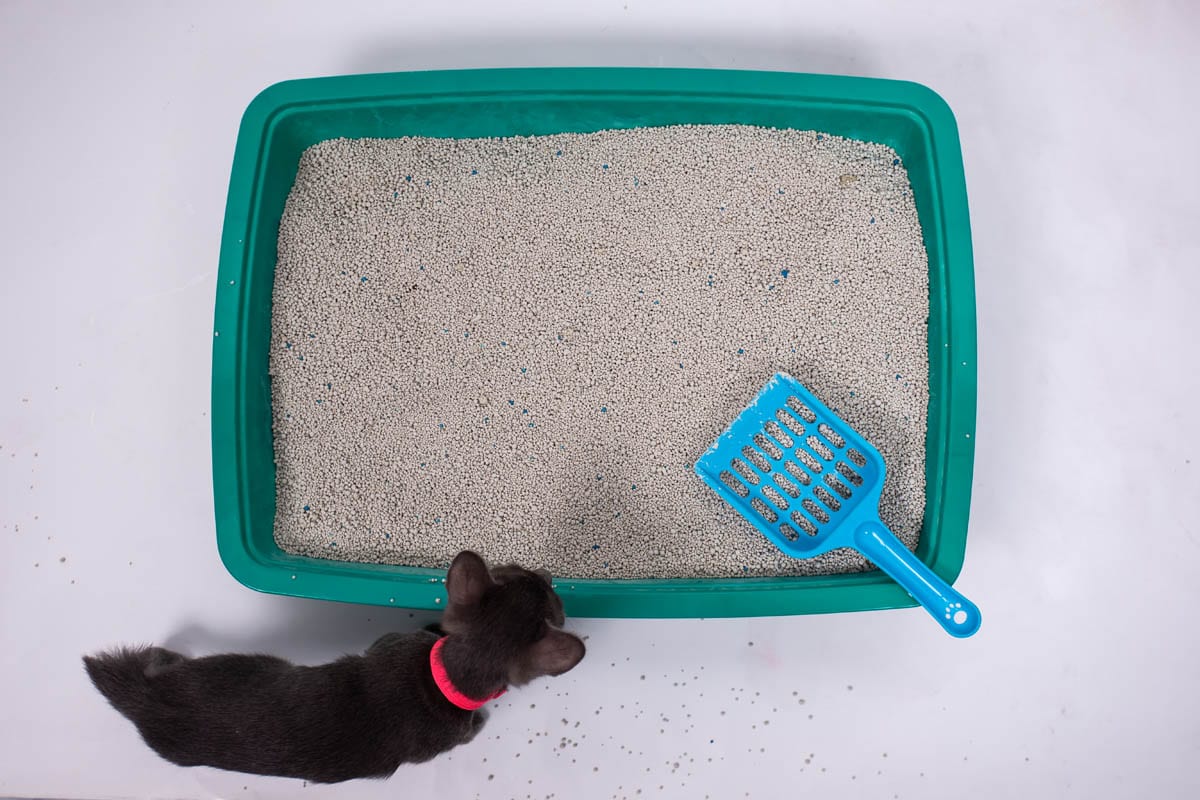Cleaning litter trays is one of the less enjoyable aspects of sharing a home with a cat, but a necessary one. Dirty litter trays not only smell unpleasant to us but our cats as well. Proper litter tray husbandry is vital, dirty litter trays can lead to inappropriate elimination.
How to dispose of cat litter
This will depend on the type of cat litter you have purchased as well as your own preferences. Cat litter made from recycled paper, food by-products (wheat, corn and soy) and wood pellets are biodegradable and can be recycled. Clay and silicone cat litters cannot be recycled.
Solid waste (feces)
No matter what type of cat litter you are using, cat feces should be bagged and disposed of in the garbage outside.
Do not flush cat feces down the toilet, due to the risk of contaminating waterways with Toxoplasma gondii. T. gondii is a protozoan intracellular parasite that infects all warm-blooded animals. Cats are the definitive host to T. gondii which means the parasite must spend its final developmental stage, and reach its mature form in the cat. Oocysts are shed in the feces and are resistant to chemical water treatment.
Human infection occurs via ingestion of undercooked meat or ingestion of sporulated oocysts in soil, and water contaminated with cat feces.
Infection in immunocompetent people is usually subclinical, however, it can form cysts within various body tissues including the brain and has been linked to several psychiatric disorders. If a woman becomes infected during pregnancy, tachyzoites can infect the fetus and cause congenital disorders (congenital toxoplasmosis), stillbirth or abortion. Immunocompromised individuals such as patients undergoing chemotherapy or people with AIDS are also at increased risk.
Urine
When a cat urinates in clumping litter, clumps form which makes them easy to scoop out. Place urine clumps in a plastic bag (along with feces), and dispose of them in the outside bin.
Wood pellets and food by-products disintegrate when wet, and if using a sieve type tray will drop into the collection tray. This can be emptied into the toilet or use a garden hose to rinse it out.
Related: Why does cat urine smell so bad?

Cat litter
Dispose of clay or silicone cat litter in a plastic bag in the outside garbage bin. Wood, food by-products and recycled paper can also be disposed of this way.
Biodegradable cat litter can be used as mulch on garden beds once feces has been removed. Do not use on vegetable gardens. I personally wouldn’t mulch cat litter in households with young children or immunocompromised individuals.
Do not flush any type of cat litter down the toilet. Large volumes of litter can cause a blockage.
Avoid composting due to the risk of contamination with t. gondii as well as parasitic worms which can survive for extended periods in the environment.
How to clean a litter tray
Remove solids from litter trays twice a day and empty, disinfect and refill with fresh litter once a week.
Weekly maintenance
- Disinfect litter trays in a well-ventilated area or outside.
- Never mix disinfectants, due to the risk of a chemical reaction that can be toxic when inhaled.
- Remove organic material such as traces of feces) with warm soapy water and a sponge or old rag, rinse well. Disinfect litter trays with a 1:10 bleach dilution using cold (not hot) water, and allow to stand for 10 minutes. Note: organic material such as feces deactivates bleach and warm water decomposes the active ingredient, which renders it ineffective.
- Discard the bleach solution and rinse well with water. Wipe the tray dry with paper towels or allow it to dry in the sun.
Cat litter safety
Always wear rubber gloves when cleaning out litter trays and wash your hands afterwards.
Pregnant women should not clean litter trays due to the risk of toxoplasmosis.
It is important to worm all cats (indoors as well as outdoors) regularly. Worm eggs pass out of the cat via the feces and can remain active in the environment for extended periods.
Take care when cleaning the litter tray of a cat who is undergoing chemotherapy or recently received radioactive iodine treatment.
Radioactive iodine treatment
For cats who have had radioactive iodine treatment for hyperthyroidism, the urine will be slightly radioactive for as long as 14 days post-discharge. Wear disposable gloves and double-bag cat litter. Store both the gloves and the discarded cat litter in a safe place for an additional two weeks to allow the radioactivity to further decay and then dispose of in the outside garbage.
Pregnant and lactating women and children should not clean litter trays of cats who have received radioactive treatment.
Chemotherapy
The body excretes chemotherapy and its metabolites via the urine and feces, take care when cleaning litter trays. Always use rubber gloves when handling the litter tray or cleaning up accidents.
Pregnant or lactating women and children should not clean out litter trays anyway, but particularly in cats who are undergoing chemotherapy. Dispose of used litter in the garbage.
Take-home points
- Dispose of clay and silicone cat litter in a plastic bag in the outside garbage.
- Cat feces are a potential source of the protozoan parasite toxoplasmosis gondii as well as parasitic worm eggs. Note: T. Gondii is not a bacteria or virus as it is wildly reported to be, it is an intracellular protozoan parasite.
- Scoop solids twice a day and empty and replace with fresh litter once a week.
- Take care when cleaning trays, always wear rubber gloves and if you are pregnant have somebody else take care of litter trays.

